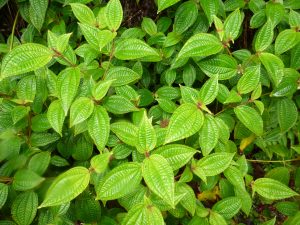THE TARGETS: CLIDEMIA (CLIDEMIA HIRTA) & MICONIA (MICONIA CALVESCENS)
- Clidemia (Clidemia hirta) and miconia (Miconia calvescens), are two of the worst invasive species to threaten our mesic and wet forests in the state. Both species are in the melastome family (Melastomataceae), of which all plants are non-native to Hawaiʻi.
- Clidemia, also known as Koster’s curse, is a shade tolerant shrub that rapidly spreads in understories and newly exposed gaps in wet and mesic forest, as well as pasturelands across the state. Birds eat the purple fruits and spread the tiny seeds (roughly 500 per fruit) to new areas.
- Miconia is nicknamed the green cancer of the Pacific. The fast growing tree with its large leaves forms dense stands that shade out other trees, overtaking wet and mesic forest and agricultural lands. A mature tree can produce over ten million seeds per year, which may remain viable for more than 20 years.
- Distribution: Koster’s curse is widespread across Kauaʻi, Oʻahu, Molokaʻi, Maui, and Hawaiʻi. Large infestations of Miconia exist on Hawaiʻi Island and Maui while small populations can be found on Kauaʻi and Oʻahu. Both weeds are native to Central and South America.
THE CANDIDATE(S): CLIDEMIA GALL WASP (ALLORHOGAS CLIDEMIA) & MICONIA GALL WASP (ALLORHOGAS GRANIVORUS)
- Two recently described species of wasps, the clidemia gall wasp (Allorhogas clidemiae) and miconia gall wasp (A. granivorus), could open a new opportunity for managing a critical life stage of clidemia and miconia – their bird-dispersed seeds.
- Both wasp species lay eggs in flower buds, where their growing larvae alter normal fruit development in the host plant, causing enlarged, hardened fruit containing galls in place of viable seeds.
- Based on life history both species of wasps, clidemiae on clidemia and A. granivorus on miconia, are very likely to be extremely specific to their host plants.
TIMELINE OF PROJECT PROGRESS:
- Trials measuring host specificity of the clidemia gall wasp are partially complete and will continue in 2021, pending delays due to COVID restrictions on international work.
- Miconia gall wasp trials will be delayed beyond those for clidemia gall wasp, because constraints in quarantine facility size increase the challenge of working with fruiting miconia trees, which can grow 50’ tall at maturity.
- Upon the completion of host specificity trials, a Draft Environmental Assessment (DEA) will be completed for the potential release of the wasp(s) in Hawaiʻi.
FURTHER INFORMATION
Miconia Invasive Species Profile (DLNR): https://dlnr.hawaii.gov/hisc/info/invasive-species-profiles/miconia/
Clidemia Invasive Species Profile (HEAR) https://www.hear.org/species/clidemia_hirta/


